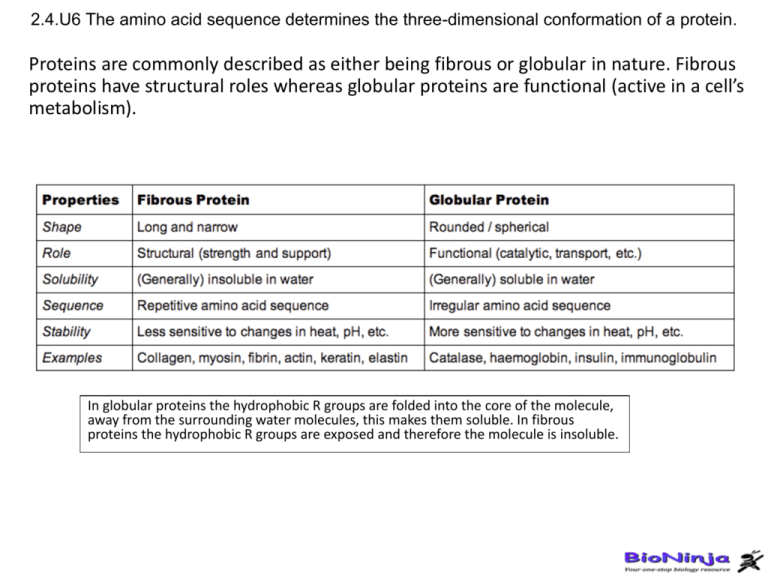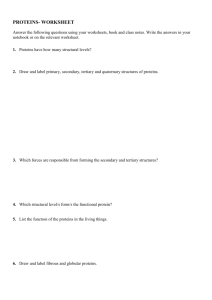Proteins part 2 ppt
advertisement

2.4.U6 The amino acid sequence determines the three-dimensional conformation of a protein. Proteins are commonly described as either being fibrous or globular in nature. Fibrous proteins have structural roles whereas globular proteins are functional (active in a cell’s metabolism). In globular proteins the hydrophobic R groups are folded into the core of the molecule, away from the surrounding water molecules, this makes them soluble. In fibrous proteins the hydrophobic R groups are exposed and therefore the molecule is insoluble. 2.4.U7 Living organisms synthesize many different proteins with a wide range of functions. Nothing can compare with the versatility of proteins. Their functionality and usage in organisms is unrivalled. Function Description There are thousands of different enzymes to catalyse specific chemical reactions within the cell or outside it. Actin and myosin together cause the muscle contractions used Muscle contraction in locomotion and transport around the body. Tubulin is the subunit of microtubules that give animals cells Cytoskeletons their shape and pull on chromosomes during mitosis. Tensile Fibrous proteins give tensile strength needed in skin, tendons, strengthening ligaments and blood vessel walls. Plasma proteins act as clotting factors that cause blood to turn Blood clotting from a liquid to a gel in wounds. Transport of Proteins in blood help transport oxygen, carbon dioxide, iron nutrients and gases and lipids. Catalysis Key examples Rubisco collagen • Key examples are outlined in more detail. • Although a key example spider silk is not mentioned above as the table refers to uses within the organism 2.4.U7 Living organisms synthesize many different proteins with a wide range of functions. Function Cell adhesion Membrane transport Hormones Receptors Packing of DNA Immunity Description Key examples Membrane proteins cause adjacent animal cells to stick to each other within tissues. Membrane proteins are used for facilitated diffusion and active transport, and also for electron transport during cell respiration and photosynthesis. Some such as insulin, FSH and LH are proteins, but hormones are Insulin chemically very diverse. Binding sites in membranes and cytoplasm for hormones, neurotransmitters, tastes and smells, and also receptors for light rhodopsin in the eye and in plants. Histones are associated with DNA in eukaryotes and help chromosomes to condense during mitosis. This is the most diverse group of proteins, as cells can make immunoglobulins huge numbers of different antibodies. Biotechnologically has allowed us to use proteins in industry examples are: • enzymes for removing stains in clothing detergent • monoclonal antibodies for pregnancy tests • insulin for treating diabetics • Disease treatments Genetically modified organisms are often used as to produce proteins. This however is still a technically difficult and expensive process. 2.4.A1 Rubisco, insulin, immunoglobulins, rhodopsin, collagen and spider silk as examples of the range of protein functions. Rubisco • • • • Full name ribulose bisphosphate carboxylase Enzyme - catalyses the reaction that fixes carbon dioxide from the atmosphere Provides the source of carbon from which all carbon compounds, required by living organisms, are produced. Found in high concentrations in leaves and algal cells http://upload.wikimedia.org/wikipedia/commons/b/b0/Mint-leaves-2007.jpg http://upload.wikimedia.org/wikipedia/commons/thumb/7/74/Rubisco.png/220px-Rubisco.png 2.4.A1 Rubisco, insulin, immunoglobulins, rhodopsin, collagen and spider silk as examples of the range of protein functions. Insulin • • • A hormone – signals many cells (e.g. liver cells) to absorb glucose and help reduce the glucose concentration of the blood. Affected cells have receptor (proteins) on their surface to which insulin can (reversibly) bind to. Secreted by β cells in the pancreas and transported by the blood. The pancreas of type I diabetics don’t produce sufficient insulin therefore they must periodically inject synthetically produced insulin to correct their blood sugar concentration. https://en.wikipedia.org/wiki/File:Inzul%C3%ADn.jpg http://www.biotopics.co.uk/as/insulinproteinstructure.html 2.4.A1 Rubisco, insulin, immunoglobulins, rhodopsin, collagen and spider silk as examples of the range of protein functions. immunoglobulins • • • • Also known as antibodies. Two antigen (a molecule on the pathogen which provokes an immune response) binding sites - one on each ‘arm’ Binding sites vary greatly between immunoglobulins (hypervariable) to enable them to respond a huge range of pathogens. Other parts of the immunoglobulin molecule cause a response, e.g. acting as a marker to phagocytes (which engulf the pathogen) https://upload.wikimedia.org/wikipedia/commons/thumb/a/a9/Antibody_IgG2.png/320px-Antibody_IgG2.png 2.4.A1 Rubisco, insulin, immunoglobulins, rhodopsin, collagen and spider silk as examples of the range of protein functions. rhodopsin • • • • • A pigment that absorbs light Membrane protein of rod cells of the retina (light sensitive region at the back of the eye) Rhodopsin consists the opsin polypeptide surrounding a retinal prosthetic group retinal molecule absorbs a single photon of light -> changes shape -> change to the opsin -> the rod cell sends a nerve impulse to the brain Even very low light intensities can be detected. http://commons.wikimedia.org/wiki/File:Rhodopsin.jpg https://en.wikipedia.org/wiki/Retina#mediaviewer/File:Fundus_photograph_of_normal_left_eye.jpg 2.4.A1 Rubisco, insulin, immunoglobulins, rhodopsin, collagen and spider silk as examples of the range of protein functions. collagen • • • • • • A number of different forms All are rope-like proteins made of three polypeptides wound together. About a quarter of all protein in the human body is collagen Forms a mesh of fibres in skin and in blood vessel walls that resists tearing. Gives strength to tendons, ligaments, skin and blood vessel walls. Forms part of teeth and bones, helps to prevent cracks and fractures to bones and teeth https://en.wikipedia.org/wiki/Tooth_(human)#mediaviewer/File:Teeth_by_David_Shankbone.jpg http://chempolymerproject.wikispaces.com/file/view/collagen_%28alpha_chain%29.jpg/34235269/collagen_%28alpha_chain%29.jpg 2.4.A1 Rubisco, insulin, immunoglobulins, rhodopsin, collagen and spider silk as examples of the range of protein functions. spider silk • • • • • Different types of silk with different functions Dragline silk is stronger than steel and tougher than Kevlar When first made it contains regions where the polypeptide forms parallel arrays (bottom) Some regions seem like a disordered tangle (middle) When the stretched the polypeptide gradually extends, making the silk extensible and very resistant to breaking. https://en.wikipedia.org/wiki/Spider_silk#mediaviewer/File:Araneus_diadematus_underside_1.jpg https://en.wikipedia.org/wiki/Spider_silk#mediaviewer/File:Structure_of_spider_silk_thread_Modified.svg 2.4.U8 Every individual has a unique proteome. Genome: all of the genes of a cell, a tissue or an organism The genome determines what proteins an organism can possibly produce. A genome is unique to most individuals (identical twins and clones share a genome) Environmental factors The environment influences what proteins an organism needs to produce and in what quantity. Example factors would be nutrition, temperature, activity levels and anything else that affects a cell’s activities. Proteome: all of the proteins produced by a cell, a tissue or an organism. • • Being a function of both the genome and the environment to which the organism is exposed the proteome is both variable (over time) and unique to every individual (including identical twins and clones). It reveals what is happening in an organism at a particular time To analyze a proteome mixtures of proteins are extracted from a sample and are then separated by gel electrophoresis. The background shows a stained example of gel electrophoresis. Q – Genome or proteome, which is larger? Explain the reasons for your answer. http://proteomics.arizona.edu/sites/proteomics.arizona.edu/files/1D_Gel_CD_4.png 2.4.U8 Every individual has a unique proteome. Q – Genome or proteome, which is larger? Explain the reasons for your answer. A – Proteome: • Not all genes produce polypeptides • Multiple polypeptides and prosthetic groups can interact • Amino acids can be modified (e.g. Collagen) • A polypeptide can fold into different levels of structure (e.g. insulin) To analyze a proteome mixtures of proteins are extracted from a sample and are then separated by gel electrophoresis. The background shows a stained example of gel electrophoresis. http://proteomics.arizona.edu/sites/proteomics.arizona.edu/files/1D_Gel_CD_4.png 2.4.A2 Denaturation of proteins by heat or by deviation of pH from the optimum. The three-dimensional conformation of proteins is stabilized by bonds or interactions between R groups of amino acids within the molecule. Most of these bonds and interactions are relatively weak and they can be disrupted or broken. This results in a change to the conformation of the protein, which is called denaturation. Heat can cause denaturation: vibrations within the molecule breaks intermolecular bonds or interactions. A denatured protein does not normally return to its former structure – the denaturation is permanent. Soluble proteins often become insoluble and form a precipitate. Extremes of pH can cause denaturation: charges on R groups are changed, breaking ionic bonds within the protein or causing new ionic bonds to form. http://upload.wikimedia.org/wikipedia/commons/2/22/Fried_egg%2C_sunny_side_up_%28black_background%29.PNG 2.4.A2 Denaturation of proteins by heat or by deviation of pH from the optimum. The background image shows white smokers, a particular kind of hydrothermal vent which produces very hot carbon dioxide gas. These vents can be found deep in oceans and produce temperatures in excess of 100 °C, but life can still be found around them. Thermophiles are organisms (often archea or eubacteria) that live in relatively hot conditions (45 to122 °C). In order that they can survive their proteins are stable at the higher than normal temperatures they experience. https://en.wikipedia.org/wiki/File:Champagne_vent_white_smokers.jpg 2.4.A2 Denaturation of proteins by heat or by deviation of pH from the optimum. Available equipment: • Waterbaths • Albumen otherwise known as egg white • Thermometers • Colorimeters (optional) Your task: determine the temperature stability of albumen http://upload.wikimedia.org/wikipedia/commons/2/22/Fried_egg%2C_sunny_side_up_%28black_background%29.PNG








